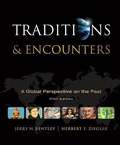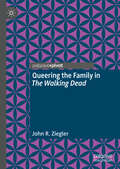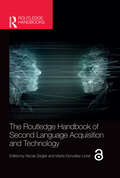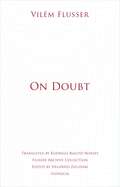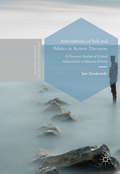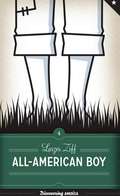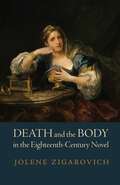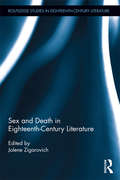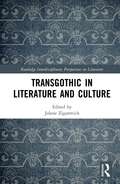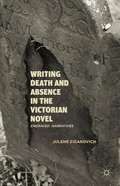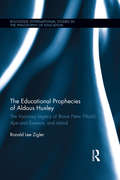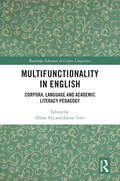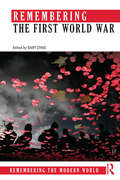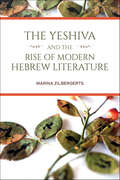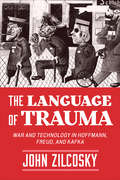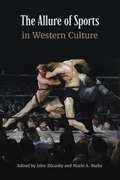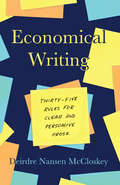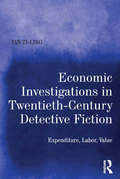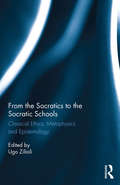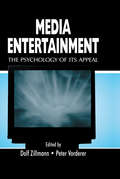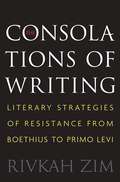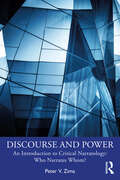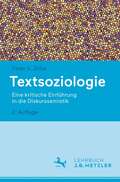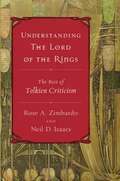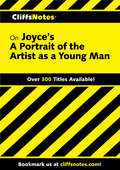- Table View
- List View
Traditions and Encounters: A Global Perspective on the Past (5th Edition)
by Herbert F. Ziegler Jerry H. BentleyConnect students to the stories of history. Connect students to the experience of history. Connect students to success in history. At McGraw-Hill, we have dedicated the past few years to deepening our understanding of student and instructor experience. Employing a wide array of research tools including surveys, focus groups, and ethnographic studies, we've identified areas in need of improvement to provide an opportunity for greater learning and teaching experiences. The fifth edition of Traditions & Encounters is a result of this. Traditions & Encounters also has a rich history of firsts: the first world history text to take a truly global perspective on the past; the first to emphasize connections among cultures; the first to combine twin themes with a seven-part framework, making the huge story of world history more manageable to both teach and learn. Now Traditions & Encounters becomes the first truly interactive world history program: one that marries groundbreaking adaptive diagnostics and interactivities with a captivating narrative and engaging visuals, creating a unique learning environment that propels greater student success and better course results. Instructors gain insight into students' engagement and understanding as students develop a base of knowledge and construct critical thinking skills. Chapter-opening vignettes and a lively narrative keep students turning the page while the adaptive questioning for each chapter and the personalized study plan for each individual student help students prepare for class discussions and course work. With its hallmark of twin themes, Traditions & Encounters continues to tell the story of the cultures and interactions that have shaped world history, while adding redesigned maps, new primary sources, and new chapter- and part-level features that strengthen connections and prompt students to analyze the events and themes in order to build a greater understanding of the past and an appreciation of history's influence on the present. Students are no longer simply reading; they are reading, interacting, and engaging in a visual, auditory, and hands-on learning experience. Give students an experience. Improve course participation and performance. Experience Traditions & Encounters, and experience success.
Queering the Family in The Walking Dead
by John R. ZieglerThis book traces how The Walking Dead franchise narratively, visually, and rhetorically represents transgressions against heteronormativity and the nuclear family. The introduction argues that The Walking Dead reflects cultural anxiety over threats to the family. Chapter 1 examines the destructive competition created by heteronormativity, such as the conflict between Rick and Shane. Chapter 2 focuses on the actual or attempted participation of characters such as Carol and Negan in queer relationships. Chapter 3 interprets zombies as queer antagonists to heteronormativity, while Chapter 4 explores the incorporation of zombies into the lives of characters such as the Governor and the Whisperers. The conclusion asserts that The Walking Dead presents both queer alternatives to and damaging contradictions within the traditional heterosexual family model, helping to question this model and to consider the struggle of queer American families. Overall, this study holds special interest for students and scholars of queerness, zombies, and the family.
The Routledge Handbook of Second Language Acquisition and Technology (The Routledge Handbooks in Second Language Acquisition)
by Nicole ZieglerTechnology- mediated language learning has matured over the past few decades, with various tools and contexts now widely used in language education for all ages and levels. Many of today’s language learners have experienced technology as an ever- present feature both within and beyond the classroom, highlighting how the role of technology has expanded into many daily activities, and underscoring how research in Second Language Acquisition (SLA) can inform and support the use of established and emerging technologies. The role of technology in language learning has continued to grow, with the recent COVID- 19 global pandemic further demonstrating the potential contributions of technology for supporting and facilitating second language development. Answering this increasing interest, this Handbook provides students, teachers, and scholars with a comprehensive collection of chapters on foundational topics and key issues related to technology, SLA, and where relevant, pedagogical applications.
On Doubt
by Siegfried Zielinski Vilém Flusser Rodrigo Maltez NovaesIn On Doubt, Vilém Flusser refines Martin Heidegger's famous declaration that "language is the dwelling of Being." For Flusser, "the word is the dwelling of being," because in fact, in the beginning, there was the word. On Doubt is a treatise on the human intellect, its relation to language, and the reality-forming discourses that subsequently emerge. For Flusser, the faith that the modern age places in Cartesian doubt plays a role similar to the one that faith in God played in previous eras--a faith that needs to be challenged. Descartes doubts the world through his proposition cogito ergo sum, but leaves doubt itself untouched as indubitable and imperious. His cogito ergo sum may have proved to the Western intellect that thoughts exist, but it did not prove the existence of that which thinks: one can eliminate thinking and yet continue being.Therefore, should we not doubt doubt itself? Should we not try to go beyond this last step of Cartesian doubt and look for a new faith? The twentieth century has seen many attempts to defeat Cartesian doubt, however, this doubt of doubt has instead generated a complete loss of faith, which the West experiences as existential nihilism. Hence, the emergent emptying of values that results from such extreme doubt. Everything loses its meaning. Can this climate be overcome? Will the West survive the modern age?
Articulations of Self and Politics in Activist Discourse: A Discourse Analysis of Critical Subjectivities in Minority Debates (Postdisciplinary Studies in Discourse)
by Jan ZienkowskiThis book focuses on the discursive processes that allow activists to make sense of themselves and of the modes of politics they engage in. It shows how political and metadiscursive awareness develop in tandem with a reconfiguration of one's sense of self. The author offers an integrated pragmatic and poststructuralist perspective on self and subjectivity. He draws on Essex style discourse theory, early pragmatist philosophy, and linguistic pragmatics, arguing for a notion of discourse as a multi-dimensional practice of articulation. Demonstrating the analytical power of this perspective, he puts his approach to work in an analysis of activist discourse on integration and minority issues in Flanders, Belgium. Subjects articulate a whole range of norms, values, identities and narratives to each other when they engage in political discourse. This book offers a way to analyse the logics that structure political awareness and the associated boundaries for discursive self-interpretation.
All-American Boy
by Larzer ZiffFrom his celebrated appearance, hatchet in hand, in Parson Mason Locke Weems's Life of Washington to Booth Tarkington's Penrod, the all-American boy was an iconic figure in American literature for well over a century. Sometimes he was a "good boy," whose dutiful behavior was intended as a model for real boys to emulate. Other times, he was a "bad boy," whose mischievous escapades could be excused either as youthful exuberance that foreshadowed adult industriousness or as deserved attacks on undemocratic pomp and pretension. But whether good or bad, the all-American boy was a product of the historical moment in which he made his appearance in print, and to trace his evolution over time is to take a fresh view of America's cultural history, which is precisely what Larzer Ziff accomplishes in All-American Boy. Ziff looks at eight classic examples of the all-American boy-young Washington, Rollo, Tom Bailey, Tom Sawyer, Ragged Dick, Peck's "bad boy," Little Lord Fauntleroy, and Penrod-as well as two notable antitheses-Huckleberry Finn and Holden Caulfield. Setting each boy in a rich cultural context, Ziff reveals how the all-American boy represented a response to his times, ranging from the newly independent nation's need for models of democratic citizenship, to the tales of rags-to-riches beloved during a century of accelerating economic competition, to the recognition of adolescence as a distinct phase of life, which created a stage on which the white, middle class "solid citizen" boy and the alienated youth both played their parts.
Death and the Body in the Eighteenth-Century Novel
by Jolene ZigarovichDeath and the Body in the Eighteenth-Century Novel demonstrates that archives continually speak to the period’s rising funeral and mourning culture, as well as the increasing commodification of death and mourning typically associated with nineteenth-century practices. Drawing on a variety of historical discourses—such as wills, undertaking histories, medical treatises and textbooks, anatomical studies, philosophical treatises, and religious tracts and sermons—the book contributes to a fuller understanding of the history of death in the Enlightenment and its narrative transformation.Death and the Body in the Eighteenth-Century Novel not only offers new insights about the effect of a growing secularization and commodification of death on the culture and its productions, but also fills critical gaps in the history of death, using narrative as a distinct literary marker. As anatomists dissected, undertakers preserved, jewelers encased, and artists figured the corpse, so too the novelist portrayed bodily artifacts. Why are these morbid forms of materiality entombed in the novel? Jolene Zigarovich addresses this complex question by claiming that the body itself—its parts, or its preserved representation—functioned as secular memento, suggesting that preserved remains became symbols of individuality and subjectivity. To support the conception that in this period notions of self and knowing center upon theories of the tactile and material, the chapters are organized around sensory conceptions and bodily materials such as touch, preserved flesh, bowel, heart, wax, hair, and bone. Including numerous visual examples, the book also argues that the relic represents the slippage between corpse and treasure, sentimentality and materialism, and corporeal fetish and aesthetic accessory.Zigarovich’s analysis compels us to reassess the eighteenth-century response to and representation of the dead and dead-like body, and its material purpose and use in fiction. In a broader framework, Death and the Body in the Eighteenth-Century Novel also narrates a history of the novel that speaks to the cultural formation of modern individualism.
Sex and Death in Eighteenth-Century Literature (Routledge Studies in Eighteenth-Century Literature #10)
by Jolene ZigarovichThis book discusses sex and death in the eighteenth-century, an era that among other forms produced the Gothic novel, commencing the prolific examination of the century’s shifting attitudes toward death and uncovering literary moments in which sexuality and death often conjoined. By bringing together various viewpoints and historical relations, the volume contributes to an emerging field of study and provides new perspectives on the ways in which the century approached an increasingly modern sense of sexuality and mortality. It not only provides part of the needed discussion of the relationship between sex, death, history, and eighteenth-century culture, but is a forum in which the ideas of several well-respected critics converge, producing a breadth of knowledge and a diversity of perspectives and methodologies previously unseen. As the contributors demonstrate, eighteenth-century anxieties over mortality, the body, the soul, and the corpse inspired many writers of the time to both implicitly and explicitly embed mortality and sexuality within their works. By depicting the necrophilic tendencies of libertines and rapacious villains, the fetishizing of death and mourning by virtuous heroines, or the fantasy of preserving the body, these authors demonstrate not only the tragic results of sexual play, but the persistent fantasy of necro-erotica. This book shows that within the eighteenth-century culture of profound modern change, underworkings of death and mourning are often eroticized; that sex is often equated with death (as punishment, or loss of the self); and that the sex-death dialectic lies at the discursive center of normative conceptions of gender, desire, and social power.
TransGothic in Literature and Culture (Routledge Interdisciplinary Perspectives on Literature)
by Jolene ZigarovichThis book contributes to an emerging field of study and provides new perspectives on the ways in which Gothic literature, visual media, and other cultural forms explicitly engage gender, sexuality, form, and genre. The collection is a forum in which the ideas of several well-respected critics converge, producing a breadth of knowledge and a diversity of subject areas and methodologies. It is concerned with several questions, including: How can we discuss Gothic as a genre that crosses over boundaries constructed by a culture to define and contain gender and sexuality? How do transgender bodies specifically mark or disrupt this boundary crossing? In what ways does the Gothic open up a plural narrative space for transgenre explorations, encounters, and experimentation? With this, the volume’s chapters explore expected categories such as transgenders, transbodies, and transembodiments, but also broader concepts that move through and beyond the limits of gender identity and sexuality, such as transhistories, transpolitics, transmodalities, and transgenres. Illuminating such areas as the appropriation of the trans body in Gothic literature and film, the function of trans rhetorics in memoir, textual markers of transgenderism, and the Gothic’s transgeneric qualities, the chapters offer innovative, but not limited, ways to interpret the Gothic. In addition, the book intersects with but also troubles non-trans feminist and queer readings of the Gothic. Together, these diverse approaches engage the Gothic as a definitively trans subject, and offer new and exciting connections and insights into Gothic, Media, Film, Narrative, and Gender and Sexuality Studies.
Writing Death and Absence in the Victorian Novel
by Jolene ZigarovichThis book asks why Bront#65533;, Dickens, and Collins saw the narrative act as a series of textual murders and resurrections? Drawing on theorists such as Derrida, Blanchot, and de Man, Zigarovich maintains that narrating death was important to the understanding of absence, separation, and displacement in an industrial and destabilized culture.
The Educational Prophecies of Aldous Huxley: The Visionary Legacy of Brave New World, Ape and Essence and Island (Routledge International Studies in the Philosophy of Education)
by Ronald ZiglerThe visionary legacy of Aldous Huxley is as relevant today as ever. Huxley possessed a sober understanding of the human condition as well as an inspired vision of the human potential. This volume presents an interdisciplinary examination and appreciation of Aldous Huxley’s three visionary novels – Brave New World (1932), Ape and Essence (1948), and Island (1962) – to reveal the extent to which Huxley’s prognoses into our possible futures was prophetic. The author assesses each novel to reveal the foresights that define our current educational, social, religious, political, and economic institutions, while also exposing our conflicts within those institutions. This volume examines the educational, cultural and technological changes that have shaped our society since Huxley’s work, with special reference to the enduring legacy of educational philosopher John Dewey. It offers profound insights into the educational forces and moral foundations of our society that shape us, both inside and outside of our schools. It is the first of its kind to focus exclusively on all three of Huxley’s visionary novels and detail their relevance to our world today.
Multifunctionality in English: Corpora, Language and Academic Literacy Pedagogy (Routledge Advances in Corpus Linguistics)
by Zihan Yin and Elaine VineThis edited volume provides detailed analyses of multifunctional forms in English and offers hands-on approaches exemplifying relevant implications and useful applications to language and literacy educators in TESOL, ESL/EFL/EAL and research students in applied linguistics and education. The chapters cover: the multifunctionality of utterances in spoken and multimodal corpora, the multifunctionality of linguistic creativity in different genres, multifunctional pronouns in hard and soft sciences, and professional discourse in the university and secondary school contexts. The volume also offers a comparison of the multifunctionality of verbs between ESL textbooks, native written and spoken English corpora, and between ESL and L1 university students in writing a particular genre; comparisons of the multifunctionality of discourse markers between different registers and between L1 and L2 English speakers, as well as multifunctional metadiscourse markers in different disciplines and paradigms. With detailed analysis of authentic corpus data representing different varieties of English, specialised use in different contexts and disciplines and practical teaching and learning applications, the volume bridges theory and practice, providing a creatively designed resource for students, educators and researchers looking to understand multifunctional forms in English.
Remembering the First World War (Remembering the Modern World)
by Bart ZiinoRemembering the First World War brings together a group of international scholars to understand how and why the past quarter of a century has witnessed such an extraordinary increase in global popular and academic interest in the First World War, both as an event and in the ways it is remembered. The book discusses this phenomenon across three key areas. The first section looks at family history, genealogy and the First World War, seeking to understand the power of family history in shaping and reshaping remembrance of the War at the smallest levels, as well as popular media and the continuing role of the state and its agencies. The second part discusses practices of remembering and the more public forms of representation and negotiation through film, literature, museums, monuments and heritage sites, focusing on agency in representing and remembering war. The third section covers the return of the War and the increasing determination among individuals to acknowledge and participate in public rituals of remembrance with their own contemporary politics. What, for instance, does it mean to wear a poppy on armistice/remembrance day? How do symbols like this operate today? These chapters will investigate these aspects through a series of case studies. Placing remembrance of the First World War in its longer historical and broader transnational context and including illustrations and an afterword by Professor David Reynolds, this is the ideal book for all those interested in the history of the Great War and its aftermath.
The Yeshiva and the Rise of Modern Hebrew Literature (Jews in Eastern Europe)
by Marina ZilbergertsThe Yeshiva and the Rise of Modern Hebrew Literature argues that the institution of the yeshiva and its ideals of Jewish textual study played a seminal role in the resurgence of Hebrew literature in modern times. Departing from the conventional interpretation of the origins of Hebrew literature in secular culture, Marina Zilbergerts points to the practices and metaphysics of Talmud study as its essential animating forces. Focusing on the early works and personal histories of founding figures of Hebrew literature, from Moshe Leib Lilienblum to Chaim Nachman Bialik, The Yeshiva and the Rise of Modern Hebrew Literature reveals the lasting engagement of modern Jewish letters with the hallowed tradition of rabbinic learning.
The Language of Trauma: War and Technology in Hoffmann, Freud, and Kafka
by John ZilcoskyFrom the Napoleonic Wars to the invention of the railway to the shell shock of World War I, writers tried to give voice to the suffering that war and industrial technology had wrought all around them. Yet they, like the doctors who treated these victims, repeatedly ran up against the incapacity of language to describe such anguish; those who suffered trauma, those who tried to heal it, and those who represented it were all unable to find the appropriate words. In The Language of Trauma, John Zilcosky uncovers the reactions of three major central European writers – E.T.A. Hoffmann, Sigmund Freud, and Franz Kafka – to the birth of modern trauma in the nineteenth and early twentieth centuries. Zilcosky makes the case that Hoffmann, Freud, and Kafka managed to find the language of trauma precisely by not attempting to name the trauma conclusively and instead allowing their writing to mimic the experience itself. Just as the victims’ symptoms seemed not to correspond to a physical cause, the writers’ words did not connect directly to the objects of the world. While doctors attempted to overcome this indeterminacy, these writers embraced and investigated it; they sought a language that described language’s tragic limits and that, in so doing, exemplified the wider literary and philosophical crisis of their time. Zilcosky boldly argues that this linguistic scepticism emerged together with the medical inability to name the experience of trauma. He thereby places trauma where it belongs: at the heart of both medicine’s diagnostic predicament and modern literature’s most daring experiments.
The Allure of Sports in Western Culture
by John Zilcosky Marlo A. BurksWhether it is our love of chance and vicarious thrill, our need to release anxiety and aggression, or our appreciation of the arc traced by a ball at a crucial moment – sports draw us in. The Allure of Sports in Western Culture contributes to contemporary debates about the attraction of sports in the West by providing a historical grounding, as well as theoretical perspectives and contextualization. Bringing together the work of literary theorists, historians, and athletes, the volume’s dual emphasis allows us to better understand the historical and ideological reasons for the changing nature of sports’ allure from Ancient Greece and Rome to the modern Olympics. The findings show that allure is shaped by larger forces such as poverty, wealth, and status; changing moral standards; and political and cultural indoctrination. On the other hand, personal and psychological factors play an equally important, if less tangible role: our love for scandal, the seduction of deception and violence, and the physiological intoxication of watching and participating in sports keep us hooked. At the heart of the volume lies the tension between our love for sport and our knowledge of its only barely hidden cruelty, exploitation, and manipulation.
Economical Writing, Third Edition: Thirty-Five Rules for Clear and Persuasive Prose (Chicago Guides to Writing, Editing, and Publishing)
by Stephen T. Ziliak Deirdre N. McCloskeyEconomics is not a field that is known for good writing. Charts, yes. Sparkling prose, no. Except, that is, when it comes to Deirdre Nansen McCloskey. Her conversational and witty yet always clear style is a hallmark of her classic works of economic history, enlivening the dismal science and engaging readers well beyond the discipline. And now she’s here to share the secrets of how it’s done. Economical Writing is itself economical: a collection of thirty-five pithy rules for making your writing clear, concise, and effective. Proceeding from big-picture ideas to concrete strategies for improvement at the level of the paragraph, sentence, or word, McCloskey shows us that good writing, after all, is not just a matter of taste—it’s a product of adept intuition and a rigorous revision process. Debunking stale rules, warning us that “footnotes are nests for pedants,” and offering an arsenal of readily applicable tools and methods, she shows writers of all levels of experience how to rethink the way they approach their work, and gives them the knowledge to turn mediocre prose into magic. At once efficient and digestible, hilarious and provocative, Economical Writing lives up to its promise. With McCloskey as our guide, it’s impossible not to see how any piece of writing—on economics or any other subject—can be a pleasure to read.
Economic Investigations in Twentieth-Century Detective Fiction: Expenditure, Labor, Value
by Yan Zi-LingIn his study of Golden Age and hard-boiled detective fiction from 1890 to 1950, Yan Zi-Ling argues that these two subgenres can be distinguished not only by theme and style, but by the way they structure knowledge, value, and productive labour. Using the detective as a reference point and enactor of socially based interests, Yan shows that Golden Age texts are distinguished by their conservationism (and not only by their conservatism), with the detectives’ actions serving to stabilize institutions with specific ideological aims. In contrast, the criminal investigations of the hard-boiled detective, who is poorly aligned with institutions and strong interest groups, reveal the fragility of the status quo in the face of escalating cycles of violence. Key to Yan’s discussion are theories of exchange, value, and the gift, the latter of which he suggests is more akin to detective work than is wage labour. Analyzing texts by a wide range of authors that includes Arthur Conan Doyle, Agatha Christie, Dashiell Hammett, Raymond Chandler, Dorothy Sayers, Raoul Whitfield, George Harmon Coxe, and Mickey Spillane, Yan demonstrates that the detective’s truth-generating function, most often characterized as a process of discovery rather than creation, is in fact crucial to the institutional and class-based interests that he or she serves.
From the Socratics to the Socratic Schools: Classical Ethics, Metaphysics and Epistemology
by Ugo ZilioliIn the two golden centuries that followed the death of Socrates, ancient philosophy underwent a tremendous transformation that culminated in the philosophical systematizations of Plato, Aristotle and the Hellenistic schools. Fundamental figures other than Plato were active after the death of Socrates; his immediate pupils, the Socratics, took over his legacy and developed it in a variety of ways. This rich philosophical territory has however been left largely underexplored in the scholarship. This collection of eleven previously unpublished essays by leading scholars fills a gap in the literature, providing new insight into the ethics, metaphysics, and epistemology as developed by key figures of the Socratic schools. Analyzing the important contributions that the Socratics and their heirs have offered ancient philosophical thought, as well as the impact these contributions had on philosophy as a discipline, this book will appeal to researchers and scholars of Classical Studies, as well as Philosophy and Ancient History.
Media Entertainment: The Psychology of Its Appeal (Routledge Communication Series)
by Dolf Zillmann Peter VordererThis collection represents a systematic exploration of media entertainment from an academic perspective. Editors Zillmann and Vorderer have assembled scholars from psychology, sociology, and communication to provide a broad examination of the primary function of media entertainment--the attainment of gratification. Chapters included here address vital aspects of media entertainment and summarize pertinent findings, providing an overview of what is presently known about the appeal and function of the essential forms of media entertainment, and offering some degree of integration. Written in a clear, non-technical style, this volume provides a lively and entertaining study of media entertainment for academic study and coursework.
The Consolations of Writing: Literary Strategies of Resistance from Boethius to Primo Levi
by Rivkah ZimWhy writing in captivity is a vitally important form of literary resistanceBoethius wrote The Consolation of Philosophy as a prisoner condemned to death for treason, circumstances that are reflected in the themes and concerns of its evocative poetry and dialogue between the prisoner and his mentor, Lady Philosophy. This classic philosophical statement of late antiquity has had an enduring influence on Western thought. It is also the earliest example of what Rivkah Zim identifies as a distinctive and vitally important medium of literary resistance: writing in captivity by prisoners of conscience and persecuted minorities.The Consolations of Writing reveals why the great contributors to this tradition of prison writing are among the most crucial figures in Western literature. Zim pairs writers from different periods and cultural settings, carefully examining the rhetorical strategies they used in captivity, often under the threat of death. She looks at Boethius and Dietrich Bonhoeffer as philosophers and theologians writing in defense of their ideas, and Thomas More and Antonio Gramsci as politicians in dialogue with established concepts of church and state. Different ideas of grace and disgrace occupied John Bunyan and Oscar Wilde in prison; Madame Roland and Anne Frank wrote themselves into history in various forms of memoir; and Jean Cassou and Irina Ratushinskaya voiced their resistance to totalitarianism through lyric poetry that saved their lives and inspired others. Finally, Primo Levi's writing after his release from Auschwitz recalls and decodes the obscenity of systematic genocide and its aftermath.A moving and powerful testament, The Consolations of Writing speaks to some of the most profound questions about life, enriching our understanding of what it is to be human.
Discourse and Power: An Introduction to Critical Narratology: Who Narrates Whom?
by Peter V. ZimaDiscourse and Power: An Introduction to Critical Narratology: Who Narrates Whom? is both an introduction to discourse research and an application of the concept of discourse to the problem of power. Divided into two sections, Part One is a presentation of the most important theories of discourse in which the link between discourse and power or language and power is central. It provides a critical overview of the most important discourse theories: Foucault, Bourdieu, Fairclough and Greimas’s structural semiotics. In Part Two, the section on practice, the insights gained in the first part of the book are applied to analyses of particular discourses and their involvement in power relations. Ranging from psychiatric, legal, political, literary and scientific discourses, examples include the presidential speeches of Obama, Trump and Biden and the novels of Camus and Pirandello. The book demonstrates that it is possible in theoretical discourse to reduce the power factor to a minimum, improve theoretical innovation, and thus pave the way for new insights in social sciences. This is an important and timely text from a leading scholar, suitable for use in discourse analysis, critical discourse analysis and rhetoric courses.
Textsoziologie: Eine kritische Einführung in die Diskurssemiotik
by Peter V. ZimaIm Anschluss an Adorno, Bachtin und Greimas’ Strukturale Semiotik analysiert Zima die Einwirkung sozialer Entwicklungen und Konfliktlinien auf literarische (und theoretische) Diskurse. Dabei geht es ebenso um Gattungsentwicklungen wie um semantische und syntaktische Strukturen einzelner Texte. Stets wird versucht, Gesellschaft und Literatur über die Sprache miteinander zu vermitteln. Der Band bietet vertiefte Analysen zu Proust, Musil und Kafka. Die Neuauflage enthält neue Kapitel zu den Begriffen der soziolinguistischen Situation, des Soziolekts sowie der Intertextualität und dehnt die Textsoziologie auf die Institutionalisierung literarischer Sprachen aus.
Understanding the Lord of the Rings: The Best of Tolkien Criticism
by Rose A. Zimbardo Neil D. IsaacsUnderstanding The Lord of the Rings: The best of Tolkien Criticism is the definitive collection of essays on Tolkien's masterpiece. The essays span fifty years of critical reaction, from the first publication of The Fellowship of the Ring Through the release of Peter Jackson's film trilogy, which inspired a new generation of readers to discover the classic work and prior generations to rediscover its power and beauty. Fans and scholars alike will appreciate these important, insightful, and timely pieces. Fourteen of the fifteen have been previously published but are gathered here for the first time. The final essay in the volume, "The Road Back to Middle-earth" by Tom Shippey was commissioned especially for this collection. Shippey examines how Peter Jackson translated the text into film drama, shaping the story to fit the understanding of a modern audience without compromising its deep philosophical core. Also included in the volume: W. H. Auden's classic, admiring essay on the true nature of the hero quest --C. S. Lewis on the value of myth--Edmund Fuller on the nature of the fairy tale--Marion Zimmer Bradley on hero worship--Jane Chance on the conflicting moral poles of ultimate good and evil. There are dozens and dozens more books by or about J. R. R. Tolkien in Bookshare's library for reading pleasure or research.
CliffsNotes on Joyce's Portrait of the Artist as a Young Man
by Valerie P ZimbaroThe original CliffsNotes study guides offer expert commentary on major themes, plots, characters, literary devices, and historical background. The latest generation of titles in this series also feature glossaries and visual elements that complement the classic, familiar format.Portrait of the Artist as a Young Man tells the semi-autobiographical account of James Joyce's first 20 years, but it is also a profound investigation into the perspective and formation of an artist. Originally intended to present the protagonist Stephen Daedalus as a renegade Catholic artist-hero, the story also succeeds as a testament of what it means to be alive and filled with curiosity, desire, and sensitivity—in short, to be an artist.CliffsNotes on Portrait of the Artist as a Young Man helps you understand the overall structure of the novel and the actions and motivations of the characters by providing you with chapter-by-chapter summaries and commentaries. Other features that help you study includeA chronology of the author's life offers insight into his writing styleDescriptive character analysesGlossaries to define new and unfamiliar termsCritical essays on Joyce’s use of imagery and autobiographyA review section that tests your knowledgeClassic literature or modern-day treasure—you'll understand it all with expert information and insight from CliffsNotes study guides.
